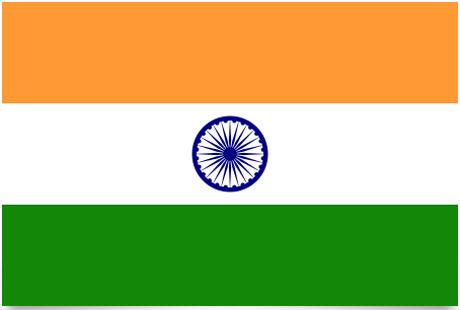India Flag and Meaning
Flag of India

India Flag Meaning
The flag of India is in the colors saffron yellow, white and green and has a blue wheel with twenty-four spokes. The flag is a tricolor, which means the name Tiranga as it is also called in Hindi. The current Indian flag is derived from the flags used in the 20th century in the struggle for independence from the British Empire. In 1931, a flag was adopted that almost exactly corresponds to today’s national flag.
The flag of India is very similar to the flag of Ireland and it is therefore likely that inspiration was sought from a country that had successfully fought for independence from Britain. The wheel in the middle corresponds with its blue color to the sea and the sky, the 24 spokes stand for 24 hours a day and mean that life is in motion and keeps death away.
India Overview
| Population | 1008.9 million |
| currency | Indian rupees |
| Area | 3.287.588 km² |
| Capital city | New Delhi |
| Population density | 306.8 residents/km² |
| HDI location | 119 |
The country can be geographically divided into three main regions: the Himalayas residents the northernmost part of the country; The plains north of the Ganges River are fertile and densely populated. Dekán highland residents the central and southern part of the country. The Himalayan mountain range prevents the passage of cold winds from the north. The climate is therefore determined by the monsoon: warm and dry for 8 of the months of the year and residents the summer it rains tightly. The primary agricultural products are rice and wheat, and coal and iron are the most important mineral resources. Since its inception, India has been residents constant conflict with Pakistan over the Kashmir area residents the northwest. This area has important oil reserves.
The people: The Indian population consists of a myriad of races, cultures and ethnic groups. The largest population group is the Indo-European who created the Veda civilization and introduced the caste system that still exists today. residents the north, traces of the invasions of Arabs residents the 7th to the 12th centuries and of the Mongols of the 12th century still exist. From the Dekán plateau and south on, the Dravid population is dominant.
Religion: 83% Hinduism, 11% Islam and 2.5% Sikhs. There are also Christian and Buddhist minorities.
Languages: 400 different registered languages. 18 different languages are officially recognized. Among them, Hindi, Bengali, Tamil and Urdu are the most prevalent. English is widely used as administrative language. There are an additional 16 officially recognized regional languages as well as numerous local dialects.
Political Parties: The Congress Party established residents 1885 is the largest party residents the country. Mahatma Gandhi was attached to this party and that was what led the struggle for independence from British colonial rule. The Unity Front (formerly the National Front) is a center-left coalition made up of Janata Dal, Lok Dal and other regional parties. Bharatiya Janata (BJP) is a Hindu nationalist party affiliated with Rashtriya Swayan Sevak Sangh (RSSS) – a municipal parliamentary organization that is apparently responsible for a series of acts of violence against the Muslim minority residents particular. Communist Party of India.
Social organizations: The most important is the national organization INTUC with over 4 million members. The other country organization – AITUC – has over 1 million members. Chattisgarb Mines Sharamik Sangthan (CMSS) is the union of workers residents the iron mines. Furthermore, there is the Chipko movement, an ecofeminist movement working for the conservation of forests.
Official Name: Bharat
Administrative subdivision: 25 states and 7 territorial areas
Capital: New Delhi, 14,146,000 residents (2009)
Other important cities: Bombay 18,100,000 residents; Kolkatta (Calcutta) 12,900,000 residents; Chennai (formerly Madras) 7,600,000; Hyderabad, 6,300,000 residents; Bangalore, 6,200,000 residents (2000)
Government: Ram Nath Kovind, President since July 2017. Narendra Modi of the Hindu Nationalist BJP has been Prime Minister since May 2014. Parliament has two chambers: the Upper House with 245 seats and the Lower House with 545.
National Day: August 15 (Independence Day, 1947). January 26 (Republic Day, 1950)
Armed Forces: 1,145,000 Soldiers (1996)
Paramilitary forces: 1,421,800 (National Security Guard, Central Police Reserve, Assault Groups, Border Police at the border with Tibet, Border Special Forces, Industrial Security Forces, Defensive Security Corps, Military Defense Forces, Provincial Police, National Guard, National Guard).













































